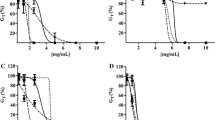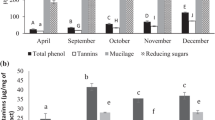Abstract
Utilization of biomass from forest or agricultural crops for the production of energy or chemical products provides environmental advantages. Leaves of the knotweeds Fallopia japonica, Fallopia sachalinensis, and Fallopia × bohemica are rich sources of phenolics and polysaccharides. In view of their potential utilization before the disposal of these invasive plants, their gross composition was investigated. The content of extractives was the highest in F. sachalinensis. Extractive-free leaves of all species showed similar chemical composition. The content of ash, protein, lignin, uronic acids, and α-cellulose in the leaves of F. sachalinensis, F. × bohemica, and F. japonica was 63.3 %, 64.1 %, and 63.4 %, respectively. The rest comprised hemicelluloses and neutral carbohydrate components of pectic polysaccharides. Sequential extraction of F. sachalinensis with water, EDTA, DMSO, 1 % NaOH, and 5 % NaOH yielded fractions accounting together for 27.6 % of polysaccharides. Pectic polysaccharides predominated in the first three fractions, whereas the hemicellulose components — xylan and xyloglucan, prevailed in the two alkaline fractions. The polysaccharides displayed significant radical scavenging activities in the 1,1-diphenyl-2-picrylhydrazyl free radical assay thus indicating their potential application as novel natural antioxidants.
Similar content being viewed by others
References
Ahmed, A. R., & Labavitch, J. M. (1978). A simplified method for accurate determination of cell wall uronide content. Journal of Food Biochemistry, 1, 361–365. DOI: 10.1111/j.1745-4514.1978.tb00193.x.
Angone, S. A., Bardor, M., Nguema-Ona, E., Rihouey, C., Ishii, T., Lerouge, P., & Driouich, A. (2009). Structural characterization of cell wall polysaccharides from two plant species endemic to central Africa, Fleurya aestuans and Phragmenthera capitata. Carbohydrate Polymers, 75, 104–109. DOI: 10.1016/j.carbpol.2008.07.003.
Balasundram, N., Sundram, K., & Samman, S. (2006). Phenolic compounds in plants and agri-industrial by-products: Antioxidant activity, occurrence, and potential uses. Food Chemistry, 99, 191–203. DOI: 10.1016/j.foodchem.2005.07.042.
Bao, X., Wang, Z., Fang, J., & Li, X. (2002). Structural features of an immunostimulating and antioxidant acidic polysaccharide from the seeds of Cuscuta chinensis. Planta Medica, 68, 237–243. DOI: 10.1055/s-2002-23133.
Beerling, D. J., Bailey, J. P., & Conolly, A. P. (1994). Fallopia japonica (Houtt.) Ronse Decraene. Journal of Ecology, 82, 959–979.
Blumenkrantz, N., & Asboe-Hansen, G. (1973). New method for quantitative determination of uronic acids. Analytical Biochemistry, 54, 484–489. DOI: 10.1016/0003-2697(73)90377-1.
Brendel, O., Iannetta, P. P. M., & Stewart, D. (2000). A rapid and simple method to isolate pure α-cellulose. Phytochemical Analysis, 11, 7–10. DOI: 10.1002/(SICI)1099-1565(200001/02)11:1<7::AID-PCA488>3.0.CO;2-U.
Browning, B. L. (1967). Methods of wood chemistry (Vol. 2). New York, NY, USA: Wiley.
Busato, A. P., Vargas-Rechia, C. G., & Reicher, F. (2001). Xyloglucan from the leaves of Hymenaea courbaril. Phytochemistry, 58, 525–531. DOI: 10.1016/S0031-9422(01)00217-5.
Capek, P., Machová, E., & Turjan, J. (2009). Scavenging and antioxidant activities of immunomodulating polysaccharides isolated from Salvia officinalis L. International Journal of Biological Macromolecules, 4, 75–80. DOI: 10.1016/j.ijbiomac.2008.10.007.
Chung, K.-T., Wong, T. Y., Wei, C.-Y., Huang, Y.-W., & Lin, Y. (1998). Tannins and human health: A review. Critical Reviews in Food Science and Nutrition, 38, 421–464. DOI: 10.1080/10408699891274273.
Ebringerová, A., Hromádková, Z., Hříbalová, V., Xu, C., Holmbom, B., Sundberg, A., & Willför, S. (2008a). Norway spruce galactoglucomannans exhibiting immunomodulating and radical-scavenging activities. International Journal of Biological Macromolecules, 42, 1–5. DOI: 10.1016/j.ijbiomac.2007.08.001.
Ebringerová, A., Hromádková, Z., Košťálová, Z., & Sasinková, V. (2008b). Chemical valorization of agricultural by-products: isolation and characterization of xylan-based antioxidants from almond shell biomass. Bioresources, 3, 60–70.
Faix, O. (1991). Classification of lignin from different botanical origins by FT-IR spectroscopy. Holzforschung, 45(Suppl.), 21–27. DOI: 10.1515/hfsg.1991.45.s1.21.
Ferreira, D., Barros, A., Coimbra, M. A., & Delgadillo, I. (2001). Use of FT-IR spectroscopy to follow the effect of processing in cell wall polysaccharide extracts of a sun-dried pear. Carbohydrate Polymers, 45, 175–182. DOI: 10.1016/S0144-8617(00)00320-9.
Gerber, E., Krebs, C., Murrell, C., Moretti, M., Rocklin, R., & Schaffner, U. (2008). Exotic invasive knotweeds (Fallopia spp.) negatively affect native plant and invertebrate assemblages in European riparian habitats. Biological Conservation, 141, 646–654. DOI: 10.1016/j.biocon.2007.12.009.
Hromádková, Z., & Ebringerová, A. (2003). Ultrasonic extraction of plant materials—investigation of hemicellulose release from buckwheat hulls. Ultrasonics Sonochemistry, 10, 127–133. DOI: 10.1016/S1350-4177(03)00094-4.
Hromádková, Z., Košťálová, Z., & Ebringerová, A. (2008). Comparison of conventional and ultrasound-assisted extraction of phenolics-rich heteroxylans from wheat bran. Ultrasonics Sonochemistry, 15, 1062–1068. DOI: 10.1016/j.ultsonch.2008.04.008.
Inoue, M., Nishimura, H., Li, H. H., & Mizutani, J. (1992). Allelochemicals from Polygonum sachalinense Fr. Schm. (Polygonaceae). Journal of Chemical Ecology, 18, 1833–1840. DOI: 10.1007/BF02751107.
Jia, Z., Tang, M., & Wu, J. (1999). The determination of flavonoid contents in mulberry and their scavenging effects on superoxide radicals. Food Chemistry, 64, 555–559. DOI: 10.1016/S0308-8146(98)00102-2.
Kačuráková, M., Capek, P., Sasinková, V., Wellner, N., & Ebringerová, A. (2000). FT-IR study of plant cell wall model compounds: pectic polysaccharides and hemicelluloses. Carbohydrate Polymers, 43, 195–203. DOI: 10.1016/S01448617(00)00151X.
Kačuráková, M., Wellner, N., Ebringerová, A., Hromádková, Z., Wilson, R. H., & Belton, P. S. (1999). Characterisation of xylan-type polysaccharides and associated cell wall components by FT-IR and FT-Raman spectroscopies. Food Hydrocolloids, 13, 35–41. DOI: 10.1016/S0268-005X(98)00067-8.
Konstantinidou-Doltsinis, S. & Schmitt, A. (1998). Impact of treatment with plant extracts from Reynoutria sachalinensis (F. Schmidt) Nakai on intensity of powdery mildew severity and yield in cucumber under high disease pressure. Crop Protection, 17, 649–656. DOI: 10.1016/S0261-2194(98)00066-0.
Košťáková, Z., Hromádková, Z., & Ebringerová, A. (2009). Chemical evaluation of seeded fruit biomass of oil pumpkin (Cucurbita pepo L. var. Styriaca). Chemical Papers, 63, 406–413. DOI: 10.2478/s11696-009-0035-5.
Larson, R. A. (1988). The antioxidants of higher plants. Phytochemistry, 27, 969–978. DOI: 10.1016/0031-9422(88)80254-1.
Mazumder, S., Morvan, C., Thakur, S., & Ray, B. (2004). Cell wall polysaccharides from Chalkumra (Benincasa hispida) fruit. Part I. Isolation and characterization of pectins. Journal of Agricultural and Food Chemistry, 52, 3556–3562. DOI: 10.1021/jf0343130.
Nuutila, A. M., Puupponen-Pimiä, R., Aarni, M., & Oksman-Caldentey, K.-M. (2003). Comparison of antioxidant activities of onion and garlic extracts by inhibition of lipid peroxidation and radical scavenging activity. Food Chemistry, 81, 485–493. DOI: 10.1016/S0308-8146(02)00476-4.
Ng, T. B., He, J. S., Niu, S.M., Zhao, L., Pi, Z. F., Shao, W., & Liu, F. (2004). A gallic acid derivative and polysaccharides with antioxidative activity from rose (Rosa rugosa) flowers. Journal of Pharmacy and Pharmacology, 56, 537–545. DOI: 10.1211/0022357022944.
Rao, R. S. P., & Muralikrishna, G. (2006). Water soluble feruloyl arabinoxylans from rice and ragi: Changes upon malting and their consequence on antioxidant activity. Phytochemistry, 67, 91–99. DOI: 10.1016/j.phytochem.2005.09.036.
Ray, B., Loutelier-Bourhis, C., Lange, C., Condamine, E., Driouich, A., & Lerouge, P. (2004). Structural investigation of hemicellulosic polysaccharides from Argania spinosa: characterisation of a novel xyloglucan motif. Carbohydrate Research, 339, 201–208. DOI: 10.1016/j.carres.2003.10.011.
Ridley, B. L., O’Neill, M. A., & Mohnen, D. (2001). Pectins: structure, biosynthesis, and oligogalacturonide-related signaling. Phytochemistry, 57, 929–967. DOI: 10.1016/S0031-9422(01)00113-3.
Proteggente, A. R., Rice-Evans, C. A., Wiseman, S., & van de Put, F. H. M. M. (2003). The relationship between the phenolic composition and the antioxidant activity of fruits and vegetables. In C. A. Rice-Evans, & L. Packer (Eds.), Flavonoids in health and disease (2nd ed., pp. 71–95). New York, NY, USA: Marcel Dekker.
Song, J.-H., Yang, T.-C., Chang, K.-W, Han, S.-K., Yi, H.-K., & Jeon, J.-G. (2007). In vitro effects of a fraction separated from Polygonum cuspidatum root on the viability, in suspension and biofilms, and biofilm formation of mutans streptococci. Journal of Ethnopharmacology, 112, 419–425. DOI: 10.1016/j.jep.2007.03.036.
Stewart, D. (1996). Fourier-transform infrared microspectroscopy of plant tissues. Applied Spectroscopy, 50, 357–365. DOI: 10.1366/0003702963906384.
Thaipong, K., Boonprakob, U., Crosby, K., Cisneros-Zevallos, L., & Byrne, D. H. (2006). Comparison of ABTS, DPPH, FRAP, and ORAC assays for estimating antioxidant activity from guava fruit extracts. Journal of Food Composition and Analysis, 19, 669–675. DOI: 10.1016/j.jfca.2006.01.003.
Vastano, B.C., Chen, Y., Zhu, N., Ho, C.-T., Zhou, Z., & Rosen, R. T. (2000). Isolation and identification of stilbenes in two varieties of Polygonum cuspidatum. Journal of Agricultural and Food Chemistry, 48, 253–256. DOI: 10.1021/jf9909196.
Vogel, J. (2008). Unique aspects of the grass cell wall. Current Opinion in Plant Biology, 11, 301–307. DOI: 10.1016/j.pbi.2008.03.002.
Vrchotová, N., Šerá, B., & Tříska, J. (2007). The stilbene and catechin content of the spring sprout of Reynoutria species. Acta Chromatographica, 2007, 21–28.
Vrchotová, N., Šerá, B., Tříska, J., Dadáková, E., & Kužel, S. (2004). Phenolic compounds in the leaves of Reynoutria Houtt. genus. In A. Hoikkala, O. Soidinsalo, & K. I. Wähälä (Eds.), Proceedings of the 22nd International Conference on Polyphenols: Polyphenols Communications, 24–28 August 2004 (pp. 811–812). Helsinki, Finland.
Weidner, S., Amarowicz, R., Karamać, M., & Dąbrowski, G. (1999). Phenolic acids in caryopses of two cultivars of wheat, rye and triticale that display different resistance to preharvest sprouting. European Food Research and Technology, 210, 109–113. DOI: 10.1007/s002170050544.
Wong, C.-C., Li, H.-B., Cheng, K.-W, & Chen, F. (2006). A systematic survey of antioxidant activity of 30 Chinese medicinal plants using the ferric reducing antioxidant power assay. Food Chemistry, 97, 705–711. DOI: 10.1016/j.foodchem.2005.05.049.
Xiao, K., Xuan, L., Xu, Y., & Bai, D. (2000). Stilbene glycoside sulfates from Polygonum cuspidatum. Journal of Natural Products, 63, 1373–1376. DOI: 10.1021/np000086+.
Yang, J., Zhou, D., & Liang, Z. (2009). A new polysaccharide from leaf of Ginkgo biloba L. Fitoterapia, 80, 43–47. DOI: 10.1016/j.fitote.2008.09.012.
Yu, Z. H., Jin, C., Xin, M., & He, J. (2009). Effect of Aloe vera polysaccharides on immunity and antioxidant activities in oral ulcer animal models. Carbohydrate Polymers, 75, 307–311. DOI: 10.1016/j.carbpol.2008.07.029.
Yuan, J.-F., Zhang, Z.-Q., Fan, Z.-C., & Yang, J.-X. (2008). Antioxidant effects and cytotoxicity of three purified polysaccharides from Ligusticum chuanxiong Hort. Carbohydrate Polymers, 74, 822–827. DOI: 10.1016/j.carbpol.2008.04.040.
Zhang, X., Thuong, P. T., Jin, W., Su, N. D., Sok, D. E., Bae, K., & Kang, S. S. (2005). Antioxidant activity of anthraquinones and flavonoids from flower of Reynoutria sachalinensis. Archives of Pharmaceutical Research, 28, 22–27. DOI: 10.1007/BF02975130.
Zhou, Z., Miwa, M., Nara, K., Wu, B., Nakaya, H., Lian, C., Miyashita, N., Oishi, R., Maruta, E., & Hogetsu, T. (2003). Patch establishment and development of a clonal plant, Polygonum cuspidatum, on Mount Fuji. Molecular Ecology, 12, 1361–1373. DOI: 10.1046/j.1365-294X.2003.01816.x.
Author information
Authors and Affiliations
Corresponding author
Rights and permissions
About this article
Cite this article
Hromádková, Z., Hirsch, J. & Ebringerová, A. Chemical evaluation of Fallopia species leaves and antioxidant properties of their non-cellulosic polysaccharides. Chem. Pap. 64, 663–672 (2010). https://doi.org/10.2478/s11696-010-0054-2
Received:
Revised:
Accepted:
Published:
Issue Date:
DOI: https://doi.org/10.2478/s11696-010-0054-2




